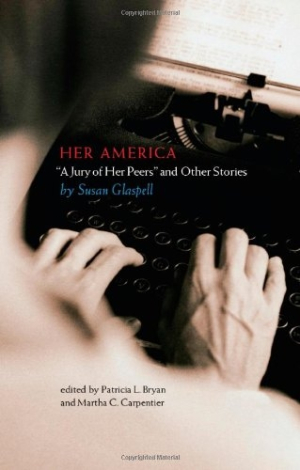Her America
“A Jury of Her Peers” and Other Stories
Critics may debate the exact period in history when women emerged as an influential force in publishing, but few will dispute the early twentieth-century impact of Susan Glaspell. Rather than accepting and glorifying established tradition, laying a typical rose-colored filter across a structured and restricted lifestyle in the name of something good, she presented realism often tempered with lighthearted humor, calling attention to inequality, oppression, and injustice. Her targets were pretense, artificiality, and insincerity, as well as basic issues like domestic violence.
Most associate Glaspell with “A Jury of Her Peers,” the gritty tale of a tormented woman driven to crime by a despicable husband. This piece appears in textbook anthologies and is subjected to intense analysis. Yet this isolated narrative does not provide an accurate or a complete picture of the author. The stories she wrote between 1915 and 1925 have not been available since their initial publication. Her America is a substantial collection of Glaspell’s work with a worthwhile introduction by two noted scholars.
Patricia L. Bryan has penned numerous articles on this literary icon. She is a professor of law at the University of North Carolina at Chapel Hill, and, with Thomas Wolf, coauthored Midnight Assassin: A Murder in America’s Heartland. Martha C. Carpentier is a distinguished expert and a professor of English at Seton Hall University and the cofounder and president of the Susan Glaspell Society. She is the author of The Major Novels of Susan Glaspell, the editor of Susan Glaspell: New Directions in Critical Inquiry, and coeditor of Disclosing Intertextualities: The Stories, Novels, and Plays of Susan Glaspell.
Glaspell holds her well-earned place in the annals of literature, esteemed as a forerunner in feminist prose. Her America is a compilation of twelve stories, followed by detailed notes and information on where each piece originally appeared. Her work was published in venerated periodicals such as Ladies Home Journal, Harper’s Monthly Magazine, and McClure’s in the days when a male-dominated society of writers accepted educated women into their midst, appreciating their talent and intellect as much as their conventional roles of mother and wife.
As a greater body of Glaspell’s work is now accessible to general readers, a welcome revival of this gifted author’s words will inspire those who wish to follow in her acclaimed footsteps. Just how she conveyed her subtle and not-so-subtle messages, using symbols and well-crafted prose, may always remain the subject of ongoing interest to other writers.
Reviewed by
Julia Ann Charpentier
Disclosure: This article is not an endorsement, but a review. The publisher of this book provided free copies of the book to have their book reviewed by a professional reviewer. No fee was paid by the publisher for this review. Foreword Reviews only recommends books that we love. Foreword Magazine, Inc. is disclosing this in accordance with the Federal Trade Commission’s 16 CFR, Part 255.

